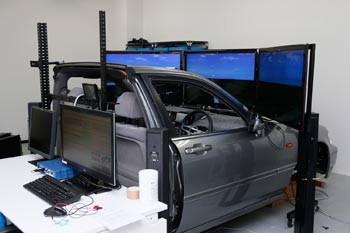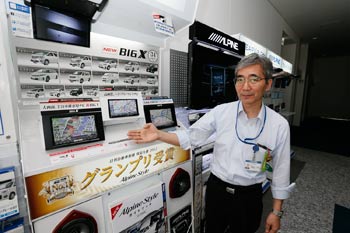This issue picks up Alpine Electronics, Inc. We focus in particular on "Advanced Development Dept." in charge of developing in-car devices and systems of the next generation using the latest ICT, and "HMI Advanced Development Team" that specialize in DD issues in the Dept..
The Company has been exploring how to develop the products that can impress the users while decreasing this DD. As part of this, it has progressed development of a system for measuring the degree to obstruct driving. UC-win/Road Drive Simulator (DS) of FORUM8 was positioned as its new base. Then the Company also introduced the cluster option of UC-win/Road Ver.7 released this April.
| Responding to the Needs of the Next Generation with a Wide Range of In-car Devices |
Alpine Electronics Co., Ltd. was founded in 1967 when the in-car device division was separated from a major manufacturer electronic parts "Alps Electric Co., Ltd.".
Achieving good results in development, manufacture, and sales of high-grade car audio systems at its establishment, the Company gradually expanded its fields into car AV (audio visual) and car navigation systems, as well as communication. Today, in addition, the Company also covers the field of driver assistance. For example, the unique products developed by the Company include the rear entertainment system considerable of the occupants, or the camera system-related product that supports drivers.
The Company has a large number of bases in and outside the country under its Tokyo head quarters (Shinagawa-city, Tokyo) and Iwaki headquarters (Iwaki city, Fukushima). The Company has a staff of about 18,000 in total all over the world.
In particular, its strong point is that development of HMI (human machine interface)-related products can be conducted in a comprehensive way within its group companies, ranging from the level of devices to in-car systems. In addition, according to Mr. Koyo Hasegawa, Chief of Advanced Development Dept., one of the features is that Iwaki headquarters has a test course for evaluating products, where they can verify the products' safety in the actual travelling environment and feed back the results to product development.
 |
| Mr. Koyo Hasegawa, Chief, Advanced Development Dept., Alpine Electronics, Inc |
| New Research System Focuses on HMI of In-car Devices |
Advanced Development Dept., where we visit for this interview, is located within Yukigaya Office of Alpine Electronics, Inc (Alpine) that occupies a part of the headquarters building of Alps Electric Co., Ltd. (ALPS) in Ota-city, Tokyo.
Alpine was originally supplying most of its products as OEM (original equipment manufacturer) products to automobile manufacturers. Recently, it has been receiving such comments from its customer companies as "what kind of influence does it have on driving to provide various information through in-car devices like car navigation systems including traffic information?" or "aren't those pieces of information distract driving?"
Then they set up for HMI Advanced Development Team in order to study these problems within the Dept. With other two participant bodies, the development staff for designing the screen in consideration of user interface (UI) and the staff from Alps in terms of input device, the new study organization went into action, as Mr. Yoshinari Ohnishi, the team leader and senior engineer of the Dept. recalls.
"There are several plans for the input method, such as using voices and gestures other than the dial or button. So we will evaluate what kind of operational method or input form works well, aiming to provide the results with our customers."
As mentioned above, the in-car device has become so complicated because ITS-related information provided by the highway-side, navigation functions, and drive-assist functions are compounded; furthermore, there may be circumstances that devices such as iPod are connected for use. It is supposed that these operations bring about DD, which may have adverse effects on safety. Consequently, it has become important how to provide HMI that does not distract the driver while selecting information as an in-car device.
In other words, as the device deals with diverse information, more input buttons are set, and in addition, it will be harder to read information on the display. This may become a factor to increase mental burden. Therefore, it was positioned to be a major goal towards product development to decrease DD as much as possible and reduce this mental burden. However, causing no distraction can mean lacking fascination as a product on the contrary. That made the Company set the development concept as "Drivers first, safe and fun in-car device".
 |
| Appearance / entrance of Yukigaya Office, Alpine Electronics, Inc. |
 |
 |
 |
|
| Mr. Ohnishi Yoshinari, senior engineer, Advanced Development Dept., Alpine Electronics, Inc. | |
| Concept of DD Evaluation and System Development |
Well then, how can DD and drivers' mental burden be measured? The Dept. first paid attention to the guideline of Japan Automobile Manufacturers Association, Inc. about the display equipment and the ISO standard on evaluation of DD. In conformity with them, they decided to build up an environment for evaluating distractions quantitatively.
In specific, DS is used in order to measure actual driving according to the ISO standard. This is to measure how much shakiness is brought about by operation of the in-car device to the driver's driving. Based on the results, the scale of driver distractions is evaluated. Moreover, it is inevitable for the driver's eye to swerve from the road while operating the in-car device or look at the display, though it may be short time. Consequently, an approach was set to evaluate whether the in-car device is easy to operate by measuring the eye movement and accuracy of driving. As the key system in accurately measuring these experiments, they introduced a desktop DS mounted with FORUM8's 3D real-time VR "UC-win/Road."
DS was so made as to represent the courses and events that reflect requirements from ISO Standards and the guidelines of NHTSA (National Highway Traffic Safety Administration) using UC-win/Road. For example, it was enabled to measure unintentional movement of the tire track in changing lanes while operating the in-car device, or effect on the distance between cars and occurrence of sway in driving while operating the in-car device.
What's more, the Dept. customized DS by adopting the cluster option of UC-win/Road and so on. Connecting measuring instruments for biological signals and DS, they also build up a system for evaluation capable of measuring. This makes it possible to intensively perform acquisition of logs, analysis, and display.
| Use and Potentiality of the Evaluation System |
The Dept. conducted joint experiments with Iwaki Meisei University using this DS and another movable DS originally owned by the Company. At this time, the software of the latter DS was replaced with UC-win/Road so that data can be used in common. This study applied virtual space and actual space to DS to compare vision, visibility, and so on, examining difference in using desktop and movable DS.
On the other hand, in the joint experiments with Shibaura Institute of Technology, heart rates, brain waves, and electrical resistance of the skin when having the subjects performing the given driving tasks with DS. Along with this, lines of sight were also detected. It was aimed to make indicators of DD using biological signals by measuring mental burden in operating the in-car device.
Through these experiments, sway in driving caused by the in-car device was quantified. Also the degree of conformance to the NHTSA guideline was measured as to gaze duration and operation time in operating the in-car device. Moreover, mental conditions of the driver were analyzed based on the biological signals. It has been proposed that these results could be reflected in the process of product development.
The Dept. assumed that such mechanism would be required that has a high degree of freedom capable of evaluating while replacing in-car devices for domestic use and export each other as needed. It was also assumed that diverse functions would be demanded capable of responding to the requirements of guidelines getting advanced. In addition, they plan to utilize this system not only for product development or design change but also as an effective tool for proposing ideas to customers.
Based on the experiences so far, Mr. Yoshinari Ohnishi expresses his expectation to the potential of DS by FORUM8 for such emerging needs.
The Company acted as a chairman company for the Car and Electronics Equipment Promotion Technical Committee in charge of exhibit of Japan Electronics and Information Technology Industries Association (JEITA). As its committee member, Mr. Koyo Hasegawa came up with an idea to focus on energy-save driving and ITS spots and have the visitors experience DS. He proposed adopting UC-win/Road DS, of which functions he was familiar with. Partly because of high assessment, JEITA decided to use the same DS also in CEATEC JAPAN this year.
"The key word 'Distraction' is frequently seen in CEATEC recently".
In this sense, simulation needs for considering "distractions" are likely to increase widely in various fields including automobiles, smart phones, and communication devices, as Mr. Koyo Hasegawa observes.
 |
| Alpine Electronics, Inc., Advanced Development Dept., HMI Advanced Development Team members |
| Specialized Navigator for All 34 Car Models "BIG X" Total Coordination of the Automobile Proposed The "BIG X" series of Alpine realizes car navigation systems that are specialized for each car model with high quality and a large screen. New BIG X embodies the concept "Alpine Style", to enrich the relationship between the driver and the car, called "Total car life solution exclusive for the car model". Alpine Style won the grand prix in the "Car Accessory Award 2012" awarded by Nikkan Jidosha Shimbun. "Specialized Perfect Fit" makes it possible to unite it with the genuine dashboard. Exclusive opening screen is adopted according to car model. Order-made system was introduced to allow provision of specialized sound tuning, specialized camera guide line tuning, and specialized picture quality tuning. The Big X device installs specialized vehicle information that allows parking lot search suitable for the vehicle size alone. Moreover, the series adopted the terrestrial digital tuner with improved receiver sensitivity and the specialized screen for the terrestrial digital. It also renovated the map database and the navigator screen. Furthermore, it provides "rear vision with plasma cluster technology" capable of coordinating with the interior. This supports safer backup operation when connected with "the specialized rear view camera linked with steering". The Best Vocal Speakers "DD linear" Realizes Sound Quality Tailored to Customer preferences The best vocal speakers "DD linear" series allow the users to tune the mid- to high- frequency ranges, realizing expressive and lively sound quality within the automobile interior. Diverse products are prepared including the improved sound quality series for exclusive use for car models, high-quality power amplifiers, and head units compatible with digital players like such as iPod. In-car Camera System "Drive Sensor" Full Lineup of Models Specialized for Each Car Model Through support for "specialized models for each car model", the in-car camera system "Drive Sensor" series enhanced the product lineup. One of them is "the rear view camera linked with steering for exclusive use for each car model". By setting this to each particular car type with the Alpine navigator, it allows more accurate driving by predicting the driving direction according to manipulation of the steering wheel and displaying the guide line. A new product of rear view camera, "HCE-C900 series", is also released, with high visibility at night, high-sensitivity, wide angle of field, and little distortion.
|
(Interviewed and written by Takashi Ikeno)


